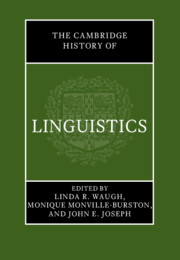Book contents
- The Cambridge History of Linguistics
- The Cambridge History of Linguistics
- Copyright page
- Dedication
- Contents
- Figures
- Tables
- Contributors
- Preface
- Acknowledgments
- Abbreviations, Acronyms, Special Symbols, and Other Conventions
- Introduction
- Part I Ancient, Classical, and Medieval Periods
- Part II Renaissance to Late Nineteenth Century
- Introduction to Part II The Cultural and Political Context of Language Studies from the Renaissance to the End of the Nineteenth Century
- 7 Universal Language Schemes
- 8 Locke and Reactions to Locke, 1700–1780
- 9 Rousseau to Kant
- 10 The Celebration of Linguistic Diversity: Humboldt’s Anthropological Linguistics
- 11 Early Nineteenth-Century Linguistics
- 12 The Neogrammarians and their Role in the Establishment of the Science of Linguistics
- Part III Late Nineteenth-through Twentieth-Century Linguistics
- Part IIIA Late Nineteenth Century through the 1950s: Synchrony, Autonomy, and Structuralism
- Part IIIB 1960–2000: Formalism, Cognitivism, Language Use and Function, Interdisciplinarity
- References
- Index
9 - Rousseau to Kant
from Part II - Renaissance to Late Nineteenth Century
Published online by Cambridge University Press: 20 July 2023
- The Cambridge History of Linguistics
- The Cambridge History of Linguistics
- Copyright page
- Dedication
- Contents
- Figures
- Tables
- Contributors
- Preface
- Acknowledgments
- Abbreviations, Acronyms, Special Symbols, and Other Conventions
- Introduction
- Part I Ancient, Classical, and Medieval Periods
- Part II Renaissance to Late Nineteenth Century
- Introduction to Part II The Cultural and Political Context of Language Studies from the Renaissance to the End of the Nineteenth Century
- 7 Universal Language Schemes
- 8 Locke and Reactions to Locke, 1700–1780
- 9 Rousseau to Kant
- 10 The Celebration of Linguistic Diversity: Humboldt’s Anthropological Linguistics
- 11 Early Nineteenth-Century Linguistics
- 12 The Neogrammarians and their Role in the Establishment of the Science of Linguistics
- Part III Late Nineteenth-through Twentieth-Century Linguistics
- Part IIIA Late Nineteenth Century through the 1950s: Synchrony, Autonomy, and Structuralism
- Part IIIB 1960–2000: Formalism, Cognitivism, Language Use and Function, Interdisciplinarity
- References
- Index
Summary
The development of linguistic thought in the second part of the eighteenth century is examined from two perspectives, anthropological and epistemological. The author shows that the sensualist tenet that linguistic signs have a formative influence on thought gradually lost ground. For Rousseau, following (and criticizing) Condillac, language is a key to the evolution of society and owes its genesis to social factors (needs and passions) and natural causes. Their intensity leads to different language types and means of cognition. In this context. various questions proposed for the Berlin Prize dealt with language (cf. essays by Michaelis, Süßmilch, Herder). The ideologues continued Condillac’s epistemological legacy and sought to provide education in proper thinking, by analyzing ideas with the aid of linguistic signs. However, some ideologues revised/limited the cognitive function of language (‘desemiotization’ of linguistic theory). Maine de Biran stressed the value of inner life against external sense experience (activity vs. sensitivity dualism). Other approaches to language study are considered: the Scottish school and Reid’s ‘common sense’ theory; Schlegel’s views on philology as art, language genesis, and the organic character of inflected languages. Kant’s transcendentalism questions the prevalent cognitive model and omits language altogether (vs. non-verbal categories) for the validation of truth.
Keywords
- Type
- Chapter
- Information
- The Cambridge History of Linguistics , pp. 281 - 307Publisher: Cambridge University PressPrint publication year: 2023

